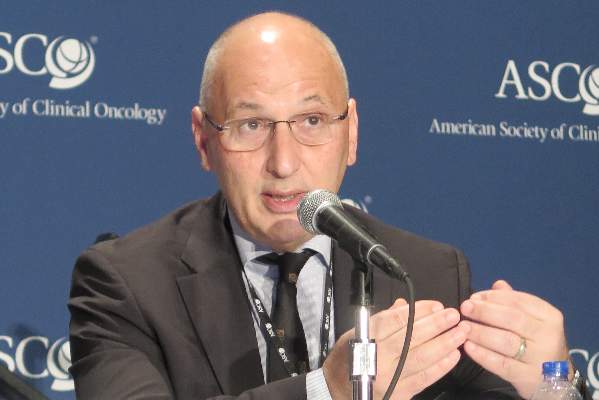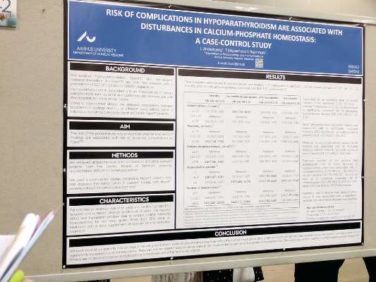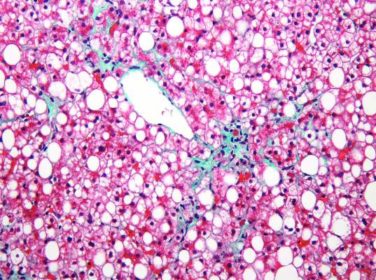AT The 2016 ASCO ANNUAL Meeting
CHICAGO (FRONTLINE MEDICAL NEWS) – Adding capecitabine to gemcitabine as adjuvant therapy prolongs survival in patients who have undergone resection of pancreatic cancer with curative intent, according to results of the European Study Group for Pancreatic Cancer’s Trial 4 (ESPAC-4).
The international phase III trial is the second largest to be conducted in this patient population, randomizing 722 patients to open-label treatment with gemcitabine monotherapy or gemcitabine-capecitabine combination therapy.
Main results showed that compared with gemcitabine alone—the standard of care worldwide—the combination gave patients an additional 2.5 months of life, reducing the risk of death by 18%, investigators reported in a session and press conference at the annual meeting of the American Society of Clinical Oncology. Moreover, this benefit was achieved without an increase in serious toxicity.
“Adjuvant gemcitabine with capecitabine is the second-step change that we can now observe for resected pancreas cancer,” lead author Dr. John P. Neoptolemos said, noting that the earlier ESPAC-2 and -3 trials represented the first-step change by establishing a survival benefit of adjuvant chemotherapy. “This is now the standard of care for resected pancreatic cancer.”
The findings of ESPAC-4 will not put adjuvant therapy in competition with neoadjuvant therapy, according to Dr. Neoptolemos, chair of surgery in the department of molecular and clinical cancer medicine at the University of Liverpool, United Kingdom.
“There are no trials showing that patients benefit from neoadjuvant therapy, so the fact that it’s used is not based on randomized trials,” he commented. “There is a trial called ESPAC-5 which is comparing straight-to-surgery with neoadjuvant therapies. One arm includes the same combination we see here, gemcitabine-capecitabine, also FOLFIRINOX, which is more toxic regimen, and also chemoradiation. I think the use of neoadjuvant therapy really requires randomized trials to determine which patients should have it and which patients will benefit from other approaches.”
“The findings from ESPAC-4 are welcome findings for our patients with pancreatic cancer,” ASCO Expert Dr. Smitha S. Krishnamurthi said in an interview. “As you know, it’s a very difficult disease to treat; most patients do succumb to this disease. But this combination has shown improved survival without increasing the rate of serious toxicity. So for patients to take an additional approved oral chemotherapy for 6 months along with the gemcitabine to potentially have improved survival I think is a very welcome finding.”
There will likely be good uptake of this combination regimen in the United States for patients who are candidates for adjuvant therapy and being treated outside of trials, she predicted.
“I definitely will be offering this to patients who are not going on clinical trial. Right now, we are participating in a neoadjuvant study. There is a lot of interest in neoadjuvant therapy, but it is not standard of care,” explained Dr. Krishnamurthi of UH Case Medical Center, and an associate professor of medicine, Case Western Reserve University School of Medicine, Cleveland, Ohio.
“So for patients who have had a potentially curative resection, gemcitabine-capecitabine represents a new standard adjuvant treatment,” she said.
In ESPAC-4, patients who no more than 12 weeks out from surgery were randomized to have six 4-week cycles of intravenous gemcitabine (Gemzar) either alone or with the addition of oral capecitabine (Xeloda).
The investigators opted to use an open-label design and not to use a placebo for several reasons, according to Dr. Neoptolemos.
“The primary endpoint is death. This is hard endpoint that would not be influenced by placebo. Toxicity is reported according to [Common Terminology Criteria for Adverse Events (CTCAE)] version 4. Every time there was a toxicity event and/or serious adverse event, the arm would need to be unblinded to determine whether or not dose reduction was required. This would involve most patients and become impracticable,” he explained in an interview. “Organizing a placebo would be very expensive with no gain.”
The trial accrued very quickly, and its steering committee asked the investigators to conduct a full analysis ahead of schedule.
Results showed that median survival was 28.0 months with the gemcitabine-capecitabine combination and 25.5 month with gemcitabine alone (hazard ratio, 0.82; P = .032). The corresponding estimated 5-year survival rates were 28.8% and 16.3%. Efficacy findings were similar across patient subgroups.
The gemcitabine-capecitabine and gemcitabine groups did not differ significantly with respect to the rate of serious adverse events (30% vs. 30%) or treatment-related serious adverse events (24% vs. 26%), although the combination was more often associated with severe diarrhea (14 vs. 5 patients). Quality of life was essentially the same for the two groups.
Dr. Neoptolemos disclosed that he receives grant and research support from Taiho Pharmaceutical, Kael-Gemvax, AstraZeneca, Clovis Oncology, Ventana, and Merck, and that he receives educational travel grants from NuCana BioMed.






